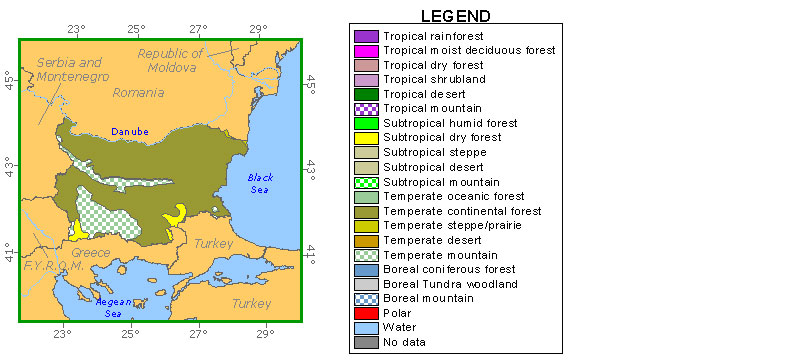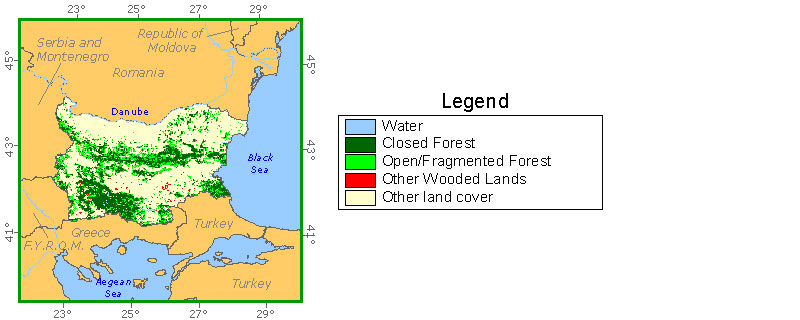BulgariaNational Plant SocietiesBotany in BulgariaTo many botanists Bulgaria is the least known and least traveled portion of the “new Europe.” The Republic of Bulgaria (110,980 km2) is part of the Balkan chain of mountains. Bulgaria is bounded by Balkan nations of Macedonia and Serbia to the West, Romania along its northern border (the Danube river), the Black Sea on the east coastline, and Turkey and Greece beyond another set of mountains on Bulgaria’s southern border. Thus, it is simultaneously almost a Mediterranean country (only a few hundred miles from the Mediterranean sea, it receives weather patterns from the Mediterranean), a Black Sea nation, and a Danubian nation as well as having extensive Balkan mountains. The southern and western portions are forested (Fig 1 and 2). The average elevation is about 480 m. The Balkan Mountains cross the country from the northwestern corner to the Black Sea and form the watershed between the Danube River and the Aegean Sea. The northern side of the Balkan Mountains slopes gradually to the Danube River to form the northern Danubian Plateau. Transitional plains lie to the south of the mountains and are an important agricultural region. The Rhodope Mountains, which form the boundary with Greece on the south, rise to the country's highest point, Musala Peak, at 2,925 m. The mountains contain a large number of ecosystems. The Black Sea coastal areas range from marsh lands in the north to wide beaches with a sloping shelf that create a marine benthic habitat. (Note that extensive pollution beyond the control of Bulgaria occurs both in the Black Sea, where it is at the receiving end of circulation from Turkey, Georgia, Russia, Ukraine, and Romania as well as down from the Danube, draining 9 nations into Bulgarian Danubian waters.) The principal river draining Bulgaria is the Danube. Several other rivers, including the Iskur and the Yantra, flow into the Danube. The Maritsa River flows east to Greece and Turkey across the Thracian Plain. Other important rivers are the Kamchiya, which empties into the Black Sea, and the Struma and Mesta, which flow south to the Aegean Sea. Most of Bulgaria has a continental climate, with cold winters and hot summers. The climate in general is more severe than in other European areas of the same latitudes, although a Mediterranean climate, with dry summers and mild, humid winters, prevails in the valley of the southwestern Rhodope Mountains. Climate can be defined as average January temperatures ranging from 2° C near the Black Sea to -17° C in central Bulgaria. July temperatures range from 16° to 27° C. The average rainfall is about 630 mm per year, ranging from a low of about 190 mm in the northeast, to a high of about 1,900 mm in the Rila Mountains. The wettest period is early summer in most of the country and autumn or winter in the southern valleys. Snowfall is generally light except in the mountains. Protected areas are generally forests or marshes. They include about 10% of the land area in 753 protected reserves. There are 16 biosphere reserves and 5 RAMSAR sites. The known number of higher plants is said to be 3,572 (FAO, 2008). Forests cover 3,625,000 ha of which 267,000 are primary, 2,028,000 ha are modified natural, 992,000 ha are semi-natural and 41,000 are plantations. This is an increase since independence in 1989 (FAO, 2005). A large and rich region of agricultural productivity lies in the valleys between the mountains and in the delta of the Danube. This area has been in cultivation for at least 9,000 years (Thracian and pre-Thracian cultures). The many nations who have dominated Bulgaria have prized exports from these soils (Greek, Roman, Turkish and USSR). Presently tobacco, fruits and vegetables are chiefly grown. A high value export product is the attar of the Bulgar rose (Rosa damascena and Rosa alba) grown in valleys in central Bulgaria, which is not a native variety, but was imported several centuries ago to service the Western European perfume business. I was fortunate to witness the late May rose production with many miles of central Bulgaria in full bloom. The forest products are largely exported lumber with no value added. This is deeply troubling since the limited forests are protected by various reserves. The outstanding institution with ongoing botanical research is the Academy of Sciences, Institute of Botany in the capital Sofia. Universities, most notably the Universities of Sofia, of Plovdiv, of Soumen, and of Stara Zagoraalso, do some botanical research beyond their teaching. The Institute of Botany maintains field facilities in the Western Rhodope Mountains, and near Dolni Lozen village. The Institute of Botany does research in the following areas: Flora and florogensis, Phytocoenology and Ecology, and Applied Botany (medicinal plants, regeneration of rare and endangered species, pollution effects on plants). They also have extensive collections of plant fossils, bryological and mycological, and vascular plants. Note that fossil pollen is a paleo-specialty. There have a series of botanical investigations at the Institute of Botany since its inception in 1947 when it merged with the Royal Institute for Science and Sofia Botanical Gardens. The staff is 100 persons with 47 Ph.D.s. The Institute of Botany has produced “The Flora of the Republic of Bulgaria” in 11 volumes, “The Fungi of Bulgaria” (1991-) in 4 volumes, “Synopsis of Flowering Plants of Bulgaria” (1980) “Guide to Mosses in Bulgaria” (1992), “Synopsis of Plant Communities in Bulgaria” (1995), “Edible and Poisonous Mushrooms in Bulgaria” (1998), “Cenozoic Plants of Bulgaria” (Eocene to Pliocene) (2005), “Atlas of Bulgarian Endemic Plants” (2006) and various proceedings of botanical conferences as well as other publications. The journal Phytologia Balcanica (since 1975) deals with taxonomy and biosystematics, chorology, floristics, evolution, phytocoenology, paleobotany, palynology, plant anatomy, embryology, ecology, and chemistry of medicinal and aromatic plants. The mean number of annual publications is 52. Obviously since Bulgaria is involved in the botanical research of the European Union and NATO there are cooperative programs with these nations for mapping (as in Natura 2000) and in CORINE, in the UNESCO_MAB programs, the EU Danubian and Balkan Flora programs. Also there are FAO and UNEP cooperative programs ongoing, as well as a Black Sea Association of Institutes. The European Initiative for Euro + Med Plant Base, Periodic Review of Bulgarian Biosphere Reserves, National Grassland Inventory Project, European Native Seed Conservation Network, Conservation and Sustainable Use of Biodiversity in Strandzha Mountain (UNESCO_MAB), Transboundary Cooperation Bulgaria-Greece (PHARE), European Pollen Bank, Evolution of Climate in the Neogene (NECLIME), and Mapping of the Flora of Europe (Finland) are international cooperative projects undertaken by the Institute of Botany. This is one in a series of national botanical profiles conceived by the International Outreach Committee of the Botanical Society of America to educate botanists about international efforts in botany. The map below shows the ecological zones, as shown on the FAO global map of ecological zones produced as part of the FRA 2000. Please refer to FRA Working Paper 20 for further information on the Global Ecological Zone map.
The designations employed and the presentation of material in this publication do not imply the expression of any opinion whatsoever on the part of the Food and Agriculture Organization of the United Nations concerning the legal status of any country, territory, city or area or of its authorities, or concerning the delimitation of its frontiers or boundaries. Map source: Global Forest Resources Assessment 2000, base map: ESRI Forest cover map
The designations employed and the presentation of material in this publication do not imply the expression of any opinion whatsoever on the part of the Food and Agriculture Organization of the United Nations concerning the legal status of any country, territory, city or area or of its authorities, or concerning the delimitation of its frontiers or boundaries. Map source: Global Forest Resources Assessment 2000, base map: ESRI The above map is an extract from the Global Forest Cover map produced as part of FRA 2000. Please refer to FRA Working Paper 19 for a background to the production of the map. Botany in Bulgaria |






